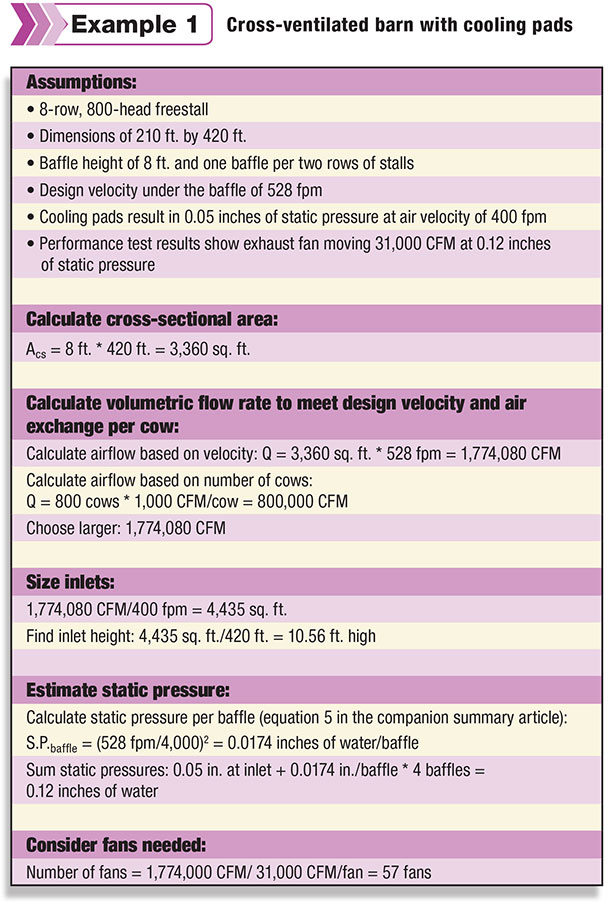This guide is a climate specific extension of the summary article “Dairy Cooling: The Benefits and Strategies” (PDF, 478KB), which describes heat stress, its costs and consequences, and strategies for its mitigation.
Herein, we focus on the unique challenges of mitigating heat stress in regions with hot summers and extremely cold winters by stepping through the facility design choices and discussing the pros and cons and costs of the dairy ventilation and cooling options for freestall barns in this climate.
Climate
The American Midwest and Northeast regions, as well as much of Europe and Asia, are dominated by climates classified as “humid continental,” which are characterized by hot summers and frigid winters, and conditions considered neither arid nor semi-arid.
The dairy cows raised in the humid continental climates of the Midwest and Northeast are, on average, not as greatly afflicted by heat stress as those raised in hotter areas (such as the states of Florida and Arizona). Nevertheless, supplemental cooling has proven effective at reducing the overall costs of heat stress and producing estimated cost savings of more than 40 percent (including the annualized capital costs and operating costs of cooling systems).
Table 1 presents the typical number of heat-stress hours in four such states and the estimated costs of heat stress under minimal heat stress abatement and with fans and sprinklers. As you can see, there is certainly a benefit to cooling cows in these humid, moderate climates.
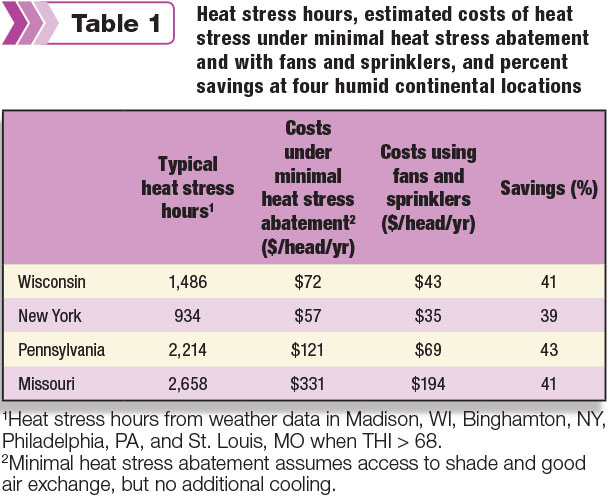
Common facilities and ventilation types
Dairy freestall barns located in areas where humid continental climates prevail typically rely on either natural or mechanical-tunnel or mechanical-cross ventilation systems. Modern, naturally ventilated barns have open sidewalls and a ridge vent along the entire length of the barn to encourage air exchange, as well as circulation fans that increase air velocity over the cows. In contrast, mechanical-tunnel and mechanical-cross ventilation systems use ventilation fans to move air through a totally enclosed barn.
A tunnel-ventilated barn will often be custom-built, but an existing, naturally ventilated barn can also be converted into a tunnel-ventilated barn by closing ridge vents and sidewalls. In recent years, a number of larger dairies have opted for cross-ventilated barns, which are characterized by their wide, low profile (and for this reason, they are sometimes referred to as “low-profile cross-ventilated” [LPCV] barns).
Insulation is often installed under the roof or in a sloped ceiling to prevent condensation and frost formation during the winter and also to protect the cows from the effects of thermal radiation during the summer.
Choosing a ventilation and cooling system
Because the ideal barn shape differs between naturally ventilated barns with circulation fans and mechanically ventilated barns, deciding which of these systems to implement is the first step. Additional equipment and design specifics can then be selected to provide evaporative cooling and high air velocity. This process is outlined in Figure 1 below.
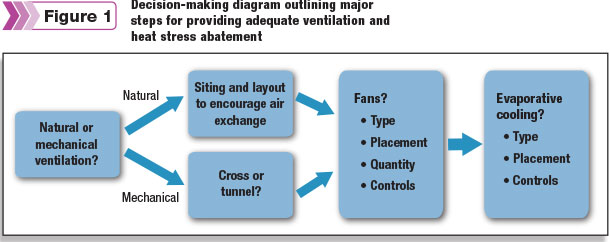
Natural or mechanical?
Both natural and mechanical ventilation systems are commonly employed at high-performing dairies in the Great Lakes region. For dairy operations involving smaller herds in areas of relatively consistent wind, natural ventilation remains the most common choice.
For the size of barn needed to house these herds, circulation fans (to supplement natural ventilation) are almost always less expensive than the exhaust fans needed for mechanical ventilation. However, the cost per cow for mechanical ventilation decreases as the tunnel-ventilated barn becomes longer (and as the cross-ventilated barn gets wider) and approaches a “critical length,” at which point the cost of exhaust fans for mechanical ventilation becomes less than the cost of placing circulation fans throughout the entire barn.
This critical length has been estimated to be about 500 feet for tunnel-ventilated barns. Mechanically ventilated barns also provide greater reliability, and because even small improvements in milk production can produce large paybacks, mechanical ventilation systems are often chosen despite requiring a greater initial investment. The pros and cons of natural and mechanical ventilation in humid continental climates are summarized in Table 2.
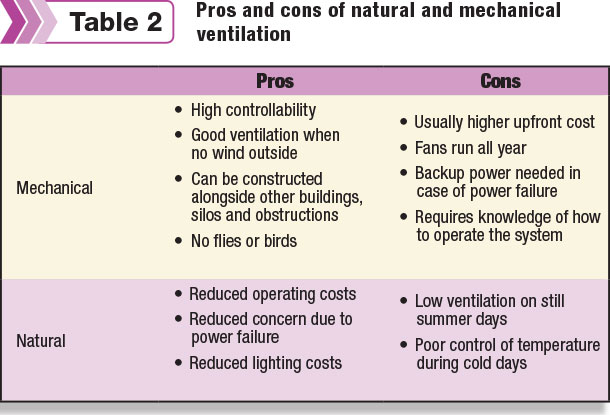
Ventilation and cooling in naturally ventilated barns
Basic siting and layout
Natural ventilation is effective at sites with consistent wind and away from other buildings and obstructions. Orienting the open sidewalls perpendicular to summertime prevailing winds provides the best ventilation, and an east-west orientation provides the best shade.
The direction and intensity of prevailing winds can be found by consulting “wind rose” diagrams, such as those found here. See Table 3 in the companion summary article (PDF, 478KB) to determine the height of sidewall openings, which is generally between 10 and 16 feet.
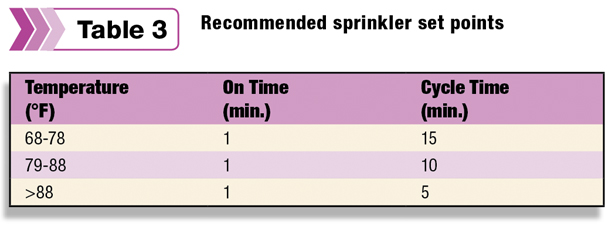
If obstructions are present, larger sidewall openings can somewhat compensate. Ridge openings should be at least 2 inches per 10 feet of building width for an open ridge and 3 inches per 10 feet of building width if a covered or overshot ridge is used.
Circulation fans for naturally ventilated barns
Type
Other than cost, several factors that should influence the selection of circulation fans are their throw, efficiency, reliability and ease of maintenance.
Location and quantity
The current recommendation for circulation fan placement is to locate one row of fans over the stalls and one row over the feedline as shown in Figure 2. This arrangement is based on a Kansas State study that compared the performance of cows housed in pens with various fan and sprinkler layouts.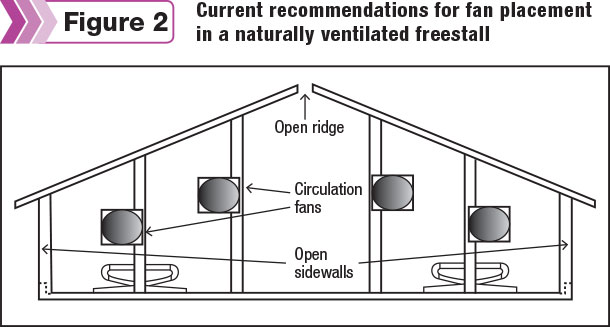
The study found that fans placed over both the feedline and stalls significantly improved milk production, but that two rows of fans installed over head-to-head stalls did not provide additional benefits.
However, if the fans placed above a row of head-to-head stalls are staggered – that is to say, if the first fan is placed to one side above the first stall and the next fan is placed above the alternate side of the next stall, and so on, then a more even airflow may be achieved.
Usually, circulation fans are placed 10 fan diameters apart, although some producers have opted to space fans more closely together to produce a greater air velocity. In any case, fans should be placed a minimum of 8 feet above the barn floor and tilted down at a 25- to 35-degree angle. The closer and higher the fans are mounted, the steeper the pitch. One should be able to feel the air at their feet when standing at the next fan.
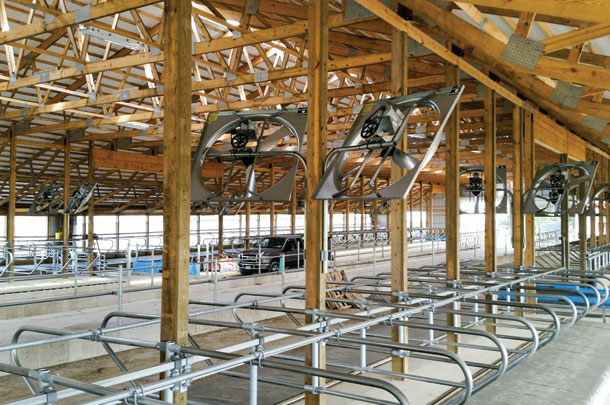
See the companion summary article for information on fan placement in the holding area.
Priority
When available funds do not cover the costs of installing circulation fans in all desired locations, the funds should be applied according to the following priority:
- Holding pens
- Close-up (dry cow) pens
- Maternity and sick pens
- Fresh cow pens
- High-producer pens
- Low-producer pens
Controls
The most recent guidelines recommend turning circulation fans on when the temperature exceeds 68°F. However, because it is the combination of temperature and humidity that causes heat stress, including a humidity sensor and setting the fans to turn on at a temperature humidity index (THI) of 68 can reduce the total number of hours the fans run per year. Variable frequency drives (VFDs) have the potential to save additional energy, but more research needs to be done to provide guidelines for how VFDs on circulation fans should be controlled.
Evaporative cooling in naturally ventilated barns
A combination of sprinklers and fans is generally more effective at reducing heat stress and provides higher economic returns than using fans alone. Sprinklers should be installed in the holding area and over the feedline, but should not be installed over the stalls as wet stalls can lead to a number of health issues.
Install a half-circle (180-degree or less) nozzle every 6 to 8 feet along the feedline, with each delivering 0.33 gallons per cow per cycle. Three hundred and sixty degree sprinklers should apply around 0.025 gallons per square foot per cycle in the holding area. Use pressure-controlled nozzles to limit system drain down (waste) and increase system responsiveness. Sprinklers should be operated in a similar manner to Table 3, although set points often also depend on available water and lagoon space.
Winter ventilation
To provide minimum ventilation while still limiting drafts, each sidewall should be open to at least half the width of the ridge opening. For example, each sidewall in a barn 100 feet wide with a 20-inch ridge opening should be open to at least 10 inches. Plan to open the sidewalls as outside temperature increases.
Ventilation and cooling in mechanically ventilated barns
Tunnel or cross?
Cross ventilation has become the preferred system in newly constructed barns housing large herds. Baffles are more effective in cross-ventilated barns than in tunnel-ventilated barns because they are placed over the freestall rows (as opposed to perpendicular to the rows), more effectively directing air to the cow level.
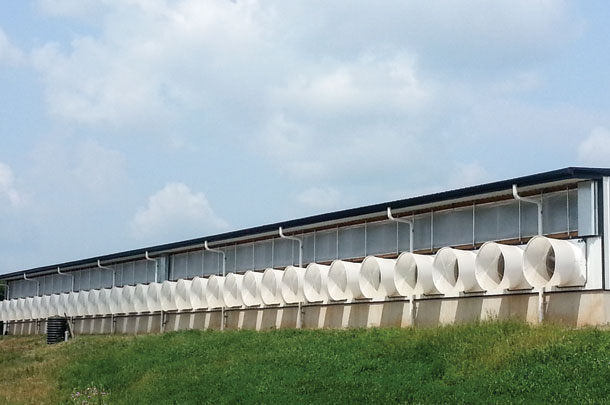
Cross ventilation is also advantageous because most of the cows will be oriented parallel to the airflow and upstream cows will block less air from reaching downstream cows than in tunnel-ventilated barns.
On the other hand, tunnel ventilation is a good option when wind alone cannot provide adequate ventilation to an existing, naturally ventilated barn. It is easier to convert naturally ventilated barns to tunnel ventilation than to cross ventilation.
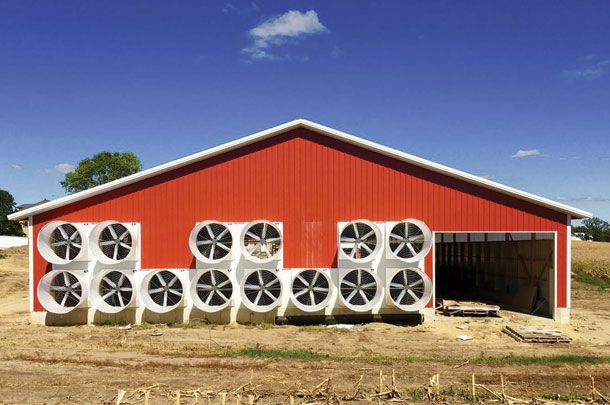
In addition, because naturally ventilated barns are usually six rows or less (and therefore significantly longer than they are wide), converting to cross requires more fans than converting to tunnel. Typically, cross-ventilated barns have a minimum of eight rows.
Evaporative cooling in mechanically ventilated barns
Mechanical ventilation is compatible with low-pressure sprinklers, high-pressure misters and evaporative cooling pads. While evaporative cooling is less effective than in arid climates, it can still provide a significant cooling effect during the hottest hours of the day (when the relative humidity [RH] is lowest).
For example, at 80°F and 50 percent RH (typical August conditions in Madison, Wisconsin), a cooling pad or misting system operating at 75 percent evaporation efficiency produces a 9.8°F temperature reduction, equivalent to a reduction in THI of 3.9 units. Cooling pads cause an increase in static pressure, while misting requires more careful control because the flow rate must be adjusted to suit changing conditions. Some dairies have removed their cooling pads to reduce static pressure and maintenance.
Baffles
Baffles are used to increase the velocity of air passing under them by reducing the cross-sectional area of the barn. Therefore, the number of fans needed to produce a given velocity can be reduced. Baffles provide benefits in cross-ventilated barns where the baffle can be oriented perpendicular to airflow to provide increased air velocity to a pen of head-to-head stalls.
However, because the air velocity is redistributed between the baffles, it is less clear whether they are worthwhile in tunnel-ventilated barns, where they only provide higher velocity air to the few stalls that they directly overhang. Some owners of tunnel-ventilated barns have opted to install full lower-level ceilings instead of baffles, which, although more expensive, increases the air velocity in the entire barn as opposed to only under the baffles.
Baffles should be high enough above the floor in feed, walk and cross alleys (12 to 13 feet) to allow equipment to pass beneath, but can be placed lower over the stalls (6 to 10 feet).
Fans for mechanical ventilation
Type
Mechanically-ventilated barns are most commonly ventilated under negative pressure using exhaust fans. Positive pressure fans are used in barns with significant infiltration, as well as the parlor, to prevent air from entering from the holding area. In general, larger fans operate more efficiently than smaller fans.
However, this is only true to a point. Independently tested 72-inch fans show dramatically reduced performance at higher static pressures. Since fan capacity decreases as static pressure increases, fans should be chosen based on how they operate at the barn’s estimated static pressure (see the companion summary article for more information on estimating the static pressure of a specific barn).
Quantity
The total ventilation capacity chosen should meet two criteria: air exchange and air velocity at cow level. Summer air exchange rates should be a minimum of 1,000 cubic feet per minute (CFM) per cow. However, this value is usually significantly exceeded to attain the desired air velocity of 400 to 600 feet per minute (fpm) at cow level. To determine the number of fans needed to provide the desired flow rate (also see Example 1 [PDF, 93KB] in appendix), use the following steps:
- Calculate cross-sectional area under baffle.
- Areacs [square feet] = heightbaffle [feet] x lengthbaffle [feet]
- Calculate airflow (Q) necessary to achieve design velocity.
- Q [CFM] = velocity [fpm] x areacs [square feet]
- Calculate airflow necessary to achieve 1,000 CFM per cow.
- Q [CFM] = 1,000 [CFM/cow] x number of cows
- Choose the larger of two airflow rates.
- Divide larger flow rate by the airflow per fan at the barn’s estimated static pressure.
- Number of exhaust fans = Q [CFM] / airflow per fan [CFM/fan]
Controls
Mechanical ventilation systems are staged so some fans are always on to provide the minimum ventilation rate (50 CFM per cow), and as the temperature increases, additional fans turn on until all the fans are on (at a temperature of 71ºF to 74°F). The airflow in some facilities is managed according to the manager’s ability to smell ammonia rather than according to air temperature. The ideal airflow required under varying conditions to exhaust gaseous emissions and mitigate heat stress (without wasting electricity) should be further investigated.
Exhaust fans equipped with VFDs can be purchased, but the airflow through the barn can also be adjusted by simply turning off some fans. VFD fans tend to be more expensive than single speed fans, but also have the potential to operate more efficiently when only a portion of the total fan capacity is needed.
Inlets
Properly sized inlets are necessary for a mechanical ventilation system to function properly. Inlets determine where air is introduced to the barn and how the air is distributed. Smaller inlets result in higher static pressure. If evaporative pads are used, airflow through the inlets should be limited to 300 to 400 CFM per square foot to limit static pressure, but the airflow can be as high as 600 to 800 CFM per sqaure foot if no pads are used.
Winter ventilation
Water and manure often freeze on the inlet side of mechanically ventilated barns as the air is introduced in one place. One potential solution is to use alternative inlets for winter ventilation that are scattered throughout the barn or a duct or poly-tube system to distribute the cold air to multiple areas of the barn.
Estimating resource use
The amount of electricity used by the fans can be estimated by multiplying the power consumption of the fans’ motors by the typical number of hours per year the fans operate (see Example 2 [PDF, 107KB] in appendix). When estimating electrical costs, note that motor horsepower is given in mechanical output and that the electrical input is always greater. A typical 1 horsepower motor requires around 1 kW of electrical power.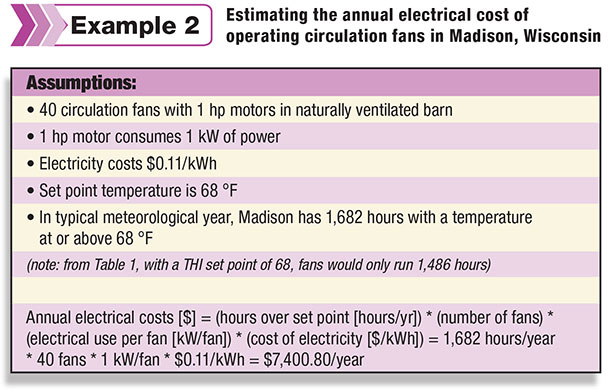
The water used by a sprinkler system can be estimated in a similar manner by multiplying the system’s set points by the typical number of hours per year within each set point range (see Example 3 [PDF, 93KB] in appendix).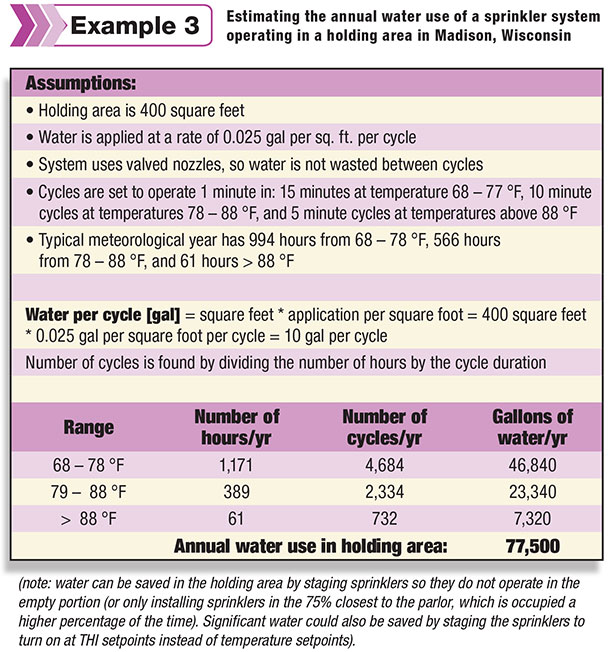
Conclusions
Implementing fans and some form of evaporative cooling has been shown to provide clear economic benefits in humid continental climates. However, determining practices that will optimize the combination of air velocity and evaporative cooling in terms of milk production, animal health and resource efficiency will require more research. Although there are gaps in the current research, the guidelines contained herein should help to reduce the negative effects of heat stress in these areas. PD
This guide is a climate-specific extension of the summary article “Dairy Cooling: The Benefits and Strategies,” which describes heat stress, its costs and consequences, and strategies for its mitigation.
References omitted but are available upon request. Click here to email an editor.
Ian Atkins is a Ph.D. student; Christopher Choi is a professor; and Brian Holmes is a professor emeritus. All authors are from the University of Wisconsin – Madison Department of Biological Systems Engineering.
PHOTO 1: Common facilities and ventilation types.
PHOTO 2: Circulation fans.
PHOTO 3: Cross Ventilation.
PHOTO 4: Tunnel Ventilation. Photos courtesy Schaefer Ventilation.
